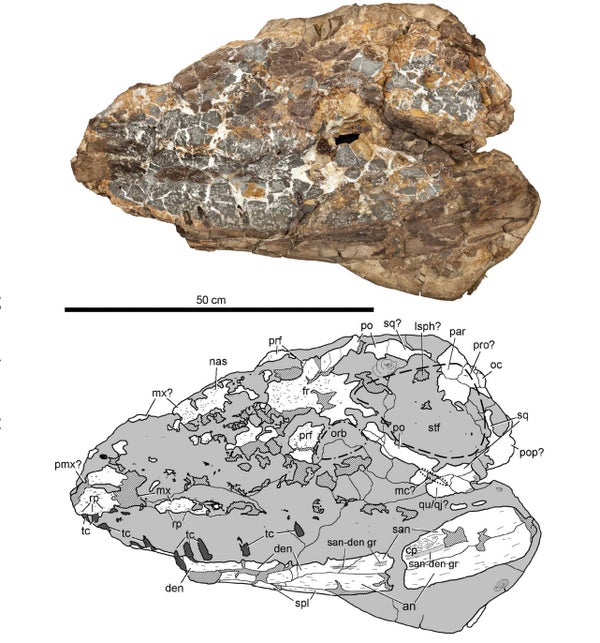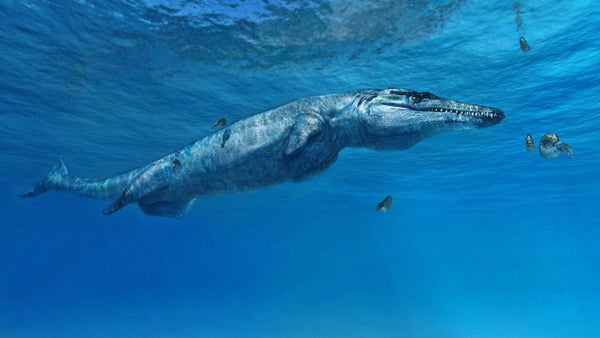This article was published in Scientific American’s former blog network and reflects the views of the author, not necessarily those of Scientific American
Not all fossils are great beauties. For every delicately-preserved feathered dinosaur or gorgeous fossil mammal with every bone still in articulation, there are dozens upon dozens of fossils that make paleontologists suck the air through their teeth in mock sympathy pain. That's just how it goes. But looks aren't everything. Even a clump of busted bone can reveal species totally unknown to us.
The skull of Ieldraan melkshamensis, described by paleontologist Davide Foffa and colleagues, is the kind of fossil that might make you cringe. The Jurassic reptile's skull is preserved inside a concretion, the overall effect looking like the world's worst jigsaw puzzle. But enough of the skull remains that Foffa and coauthors were able to tell that it represents a previously-unknown form of marine crocodile that was swimming through Jurassic seas about 163 million years ago.
New prep work on the fossil - first collected in the 19th century and neglected since then - allowed Foffa and colleagues to detect this hidden croc. IIeldraan melkshamensis was one of many marine crocodiles that sculled through the oceans during the Jurassic, and analysis of this new fossil - as well as others - have allowed paleontologists to better understand how this long-lost group diversified. After looking at the teeth of these crocodiles and their evolutionary relationships, for example, Foffa and colleagues determined that marine crocodiles evolved a lifestyle of feeding on large prey at least four times. Apparently there was a seaborne smorgasbord just waiting to be eaten.
On supporting science journalism
If you're enjoying this article, consider supporting our award-winning journalism by subscribing. By purchasing a subscription you are helping to ensure the future of impactful stories about the discoveries and ideas shaping our world today.

The skull of Ieldraan. Credit: Foffa et al 2017
Fossil Facts
Name: Ieldraan melkshamensis
Meaning: Ieldraan means "Older One" in Old English, and melkshamensis is a reference to where the fossil was found.
Age: Jurassic, about 163 million years ago.
Where in the world?: Melksham, England.
What sort of organism?: A marine crocodile called a metriorhynchid.
How much of the organism’s is known?: A damaged skull and part of the lower jaw.
References:
Foffa, D., Young, M., Brusatte, S., Graham, M., Steel, L. 2017. A new metriorhynchid crocodylomorph from the Oxford Clay Formation (Middle Jurassic) of England, with implications for the origin and diversification of Geosaurini. Journal of Systematic Palaeontology. doi: 10.1080/14772019.1367730
Previous Paleo Profiles:
The Light-Footed Lizard The Maoming Cat Knight’s Egyptian Bat The La Luna Snake The Rio do Rasto Tooth Bob Weir's Otter Egypt's Canine Beast The Vastan Mine Tapir Pangu's Wing The Dawn Megamouth The Genga Lizard The Micro Lion The Mystery Titanosaur The Echo Hunter The Lo Hueco Titan The Three-Branched Cicada The Monster of Minden The Pig-Footed Bandicoot Hayden's Rattlesnake Demon The Evasive Ostrich Seer The Paradoxical Mega Shark The Tiny Beardogs The Armored Fish King North America's Pangolin The Invisible-Tusked Elephant The Mud Dragon The Spike-Toothed Salmon The Dream Coast Crocodile Buriol's Robber Ozimek's Flyer The Northern Naustoceratopsian The High Arctic Flyer The Tomatillo From the End of the World The Short-Faced Hyena The Mighty Traveler from Egg Mountain Keilhau's Ichthyosaur Mexico's Ancient Horned Face Mauricio Fernández's Plesiosaur New Zealand's Giant Dawn Penguin The Orange Sea Lion Mongolia's Ginkgo Cousin The Geni River Frog Isabel Berry's Dinosaur The Whale Caiman The Moab Lizard Yang Zhongjian's Lizard The Little Anubis The Shuangbai Lizard The Wyvern Dinosaur The "Need Helmet" Dinosaur The Jianianhua Dragon The Liaoning Hunter The Dalian Lizard Crompton's Aleodon Jenkins' Amphibian Serpent From the Chinle The Large Ancestor Lizard The Crown Tooth Currie's Alberta Hunter The Elephant Bird Mimic The Crested Thief The Hiding Hunter The Horned Lizard The Silk Bird The Sieve-Toothed Plesiosaur The Defenseless Snout Burian's Lizard The Small Whaitsiid The Beautiful Bird The Fierce Cat
